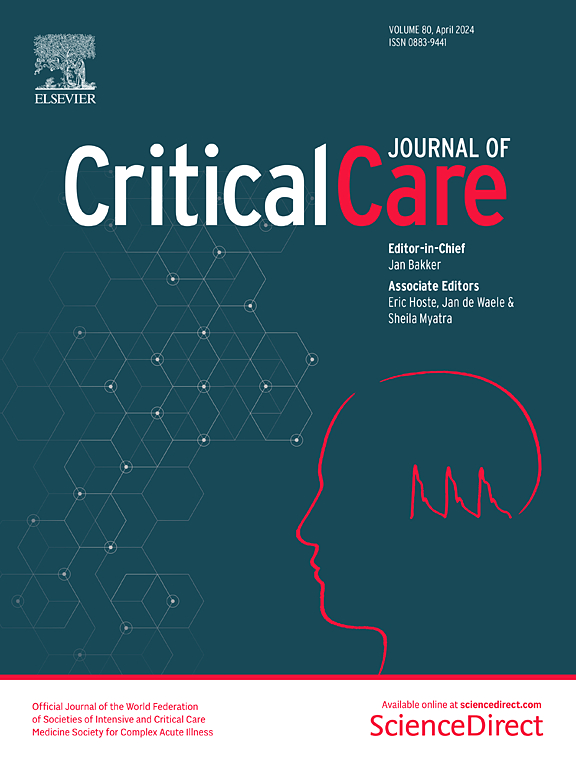急性脑损伤成年患者高氧血症后的神经预后和死亡率:最新的荟萃分析和荟萃回归
IF 8.8
1区 医学
Q1 CRITICAL CARE MEDICINE
引用次数: 0
摘要
本研究旨在评估动脉高氧血症与急性脑损伤(ABI)成人患者的神经系统预后和死亡率之间的关系。研究人员系统检索了从开始到 2024 年 6 月 1 日的六个电子数据库,包括 MEDLINE、Embase 和临床试验在线登记。根据 PRISMA 指南,纳入了比较高氧血症与无高氧血症对 ABI 相关疾病(如创伤性脑损伤、心脏骤停后、蛛网膜下腔出血、脑内出血和缺血性中风)住院成年患者预后影响的研究。采用随机效应模型对未调整和协变量调整后的几率比进行数据汇总。主要结果为各研究定义的神经系统不良预后,次要结果为全因死亡率。根据主要诊断、结果测量的时间、氧合作用阈值等因素进行了分组分析。应用元回归来确定异质性的来源。在筛选了 7849 份不重复的记录后,有 66 项研究符合系统综述的资格标准。包括 24 项研究(16,635 名患者)的荟萃分析表明,与无高氧血症的患者相比,高氧血症患者出现不良神经系统预后的可能性是无高氧血症患者的 1.29 倍(未调整 OR,1.295;95% 置信区间,CI 1.040-1.616),尤其是在蛛网膜下腔出血和缺血性卒中亚组。包括 35 项研究(98 207 名患者)在内的荟萃分析显示,与无高氧血症患者相比,高氧血症患者的全因死亡率是无高氧血症患者的 1.13 倍(OR 1.13;95% CI 1.002-1.282)。在我们的研究中,我们发现与无高氧血症患者相比,高氧血症与急性脑损伤患者神经系统不良预后和死亡风险的增加密切相关。我们的研究结果表明,在神经重症监护病房中仔细调整氧合策略非常重要。本文章由计算机程序翻译,如有差异,请以英文原文为准。
Neurological outcomes and mortality following hyperoxemia in adult patients with acute brain injury: an updated meta-analysis and meta-regression
The aim of this study was to evaluate the association of arterial hyperoxemia with neurological outcomes and mortality in adults with acute brain injury (ABI). Six electronic databases, including MEDLINE, Embase and online registers of clinical trials, were systematically searched from inception to June 1 st, 2024. Studies comparing the effects of hyperoxemia versus no hyperoxemia on outcomes of hospitalized adult patients with ABI-related conditions (e.g. traumatic brain injury, post-cardiac arrest, subarachnoid hemorrhage, intracerebral hemorrhage, and ischemic stroke) were included according to PRISMA guidelines. Data were pooled using a random-effects model for unadjusted and covariate-adjusted odds ratios. The primary outcome was poor neurological outcome as defined by each individual study, and the secondary outcome was all-cause mortality. Subgroup analyses were conducted based on principal diagnosis, timing of outcome measures, oxygenation thresholds, among other factors. Meta-regression was applied to identify sources of heterogeneity. After 7,849 nonduplicated records were screened, 66 studies fulfilled eligibility criteria for systematic review. The meta-analysis including 24 studies (16,635 patients) revealed that patients with hyperoxemia are 1.29 times more likely to develop poor neurological outcomes (unadjusted OR, 1.295; 95% Confidence Interval, CI 1.040–1.616) compared with those with no hyperoxemia, particularly in subarachnoid hemorrhage and ischemic stroke subgroups. The meta-analysis including 35 studies (98,207 patients) revealed that all-cause mortality is 1.13 times more likely (OR 1.13; 95% CI 1.002–1.282) in patients with hyperoxemia compared with no hyperoxemia. In our study we found that hyperoxemia is significantly associated with an increased risk of poor neurological outcomes and mortality in patients with acute brain injury compared to those with no hyperoxemia. Our results suggest the importance of carefully adjusting oxygenation strategies in neurocritical ICUs.
求助全文
通过发布文献求助,成功后即可免费获取论文全文。
去求助
来源期刊

Critical Care
医学-危重病医学
CiteScore
20.60
自引率
3.30%
发文量
348
审稿时长
1.5 months
期刊介绍:
Critical Care is an esteemed international medical journal that undergoes a rigorous peer-review process to maintain its high quality standards. Its primary objective is to enhance the healthcare services offered to critically ill patients. To achieve this, the journal focuses on gathering, exchanging, disseminating, and endorsing evidence-based information that is highly relevant to intensivists. By doing so, Critical Care seeks to provide a thorough and inclusive examination of the intensive care field.
 求助内容:
求助内容: 应助结果提醒方式:
应助结果提醒方式:


